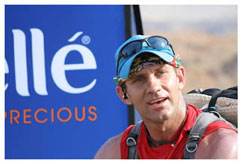By Dirk Cloete
Desert running requires physical stamina, endurance and mental tenacity. However, training to run through the desert is quite important if you want to have a successful race.
 According to the statistics of Racing the Planet, the company who presents the 4-Deserts Series approximately 20% of participants run the entire course. However, the specific course dictates this number while weather conditions and the “running” pace are also contributing factors.
According to the statistics of Racing the Planet, the company who presents the 4-Deserts Series approximately 20% of participants run the entire course. However, the specific course dictates this number while weather conditions and the “running” pace are also contributing factors.
Between CP’s 3 and 4 on Day 4 of 2010 Hylton and I were progressing so slow in the 50 degree Celsius heat and strong headwind that we might as well have switched to a recognised walk and probably have gone faster that way.
Desert Running in the Kalahari
Very few participants will run the entire course of a desert running event such as KAEM. However, it’s a privilege for me to put forward some guiding tips for those who aim to “run” the majority of the route. I’ll share as much of my knowledge and experience as what might be useful. The one thing I’ve learnt after a long time of running is that one has to take the advice and programs of the experts and adjust it according to your own abilities. Only after I’ve figured out what is enough and what is too much training for me was when I started achieving better results.
Therefore, my first advice is to take what you read here and apply it within your own framework of ability, experience and fitness level, and work out your own desert running training regime.
Since I started with trail running I’ve also learned the benefit of training in specific cycles for major races. If you do just one big race, like the KAEM per year then unfortunately it will mean training all year just for that. However, if you have other major events on the way to KAEM you can adjust the specific cycle of KAEM training accordingly. This can range from as short as 8 weeks (in 2011 I did the Gobi in July and only trained 8 weeks for Augrabies) to as long as 20 weeks. Just a reminder that I’m referring to athletes who are very fit already by the time they start with their specific preparation for KAEM. Please don’t think for one moment you can start with no base, prepare for the KAEM in 20 weeks and expect to run the entire distance at a competitive pace.
Training during a 12 week cycle should include at least the following 3 phases:
- Four (4) weeks of Building base and strength
- 4 weeks of high mileage
- 4 weeks of quality
A typical training week could look like this:
Monday: 8 km (easy)
Tuesday: 8 km (easy); 9 km hills [8 x 300m hill]
Wednesday: 6 km (easy); 20 km quality
Thursday: 8 km (easy)
Friday: 6 km (easy); 7 km track [6 x 600 m with 200 m recovery jog]
Saturday: 30 km (easy)
Sunday: Rest
You would need to adjust the volume and type of quality work according to the phase of the program you’re in.
Select a specific cycle for structured training which is just aimed at desert running
There are various convictions as far as training with a backpack goes. Many people prefer to do every run with the pack to get used to it. Others again only run a few times with it to harden the skin and make sure the bag fits properly.
I believe in training enough to get used to the bag. However, at the same time, I caution against overtraining with it.
As far as nutrition and hydration go there is loads of information available on the KAEM website and other sources. Elite athletes usually ensure that they have all the latest information in this regard. The temperatures at the KAEM can vary significantly from one year to the next. This influences the total race time.
Adjust your nutrition and hydration regime to compensate for the influence of the possible heat of the desert.
One aspect about the KAEM which is different (and I personally like it) is that the route changes every year. The composition of sand, jeep track and technicality can vary significantly. This means that nobody has any advantage by knowing the route beforehand. In other words, you cannot train on route information like many of the top runners would do at other international races. Not everybody is close to terrain which simulates the routes at Augrabies. But it would be helpful to do a large portion of your training on terrain which is as representative of the expected route as possible. However, you can develop your fitness and ability in many different ways. So, it doesn’t mean you’ll not be able to be competitive if you don’t live and train in a desert every day.
Do as much training as possible on routes which simulate the terrain of desert running.
The conditions at the KAEM are harsh. Many experienced international competitors will often describe it very aptly as “ANGRY”. Some of the luxuries which runners enjoy at other desert races around the world are ABSENT at the KAEM. It is self-sufficient pretty much to the letter of the rule.
Make sure your gear is suitable for the conditions
Lastly, regardless of how competitive you’re running, KAEM will take you on a journey, both physically and spiritually. You will run through the most spectacular and unspoiled desert landscapes. You will experience here what you will never experience in any other race in the world. It is PURE desert running.
Remember to look around, absorb and enjoy the beauty of the Kalahari Desert.
FOR MORE INFORMATION ABOUT KAEM and what this extraordinary event is all about, browse the website and get in contact with Nadia at nadia@dev.kaem.co.za. Also be sure to like the KAEM Facebook page to follow the event developments.
